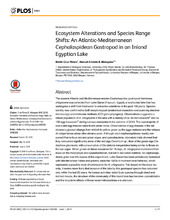| dc.contributor.author | Cruz-Rivera, Edwin | |
| dc.contributor.author | Malaquias, Manuel Antonio E. | |
| dc.date.accessioned | 2017-04-04T14:34:53Z | |
| dc.date.available | 2017-04-04T14:34:53Z | |
| dc.date.issued | 2016-06 | |
| dc.Published | PLoS ONE 2016, 11:e0156760(6) | eng |
| dc.identifier.issn | 1932-6203 | |
| dc.identifier.uri | https://hdl.handle.net/1956/15672 | |
| dc.description.abstract | The eastern Atlantic and Mediterranean marine Cephalaspidea gastropod Haminoea orbignyana was collected from Lake Qarun (Fayoum, Egypt), a landlocked lake that has undergone a shift from freshwater to estuarine conditions in the past 100 years. Species identity was confirmed by both morphological (anatomical dissection and scanning electron microscopy) and molecular methods (COI gene phylogeny). Observations suggested a robust population of H. orbignyana in the lake with a density of ca. 64 individuals/m2 and ca. 105 egg masses/m2 during surveys conducted in the summer of 2013. The vast majority of snails and egg masses were found under rocks. Observations of egg masses in the lab showed a gradual change from whitish to yellow-green as the eggs matured and the release of veliger larvae alone after about a week. Although adult cephalaspideans readily consumed filamentous red and green algae, and cyanobacteria, laboratory trials showed that they consumed significantly more of the red alga Ceramium sp., than of the green alga Cladophora glomerata, with consumption of Oscillatoria margaritifera being similar to those on the two algae. When grown on these resources for 16 days, H. orbignyana maintained their mass on the rhodophyte and cyanobacterium, but not in starvation controls. No cephalaspideans grew over the course of this experiment. Lake Qarun has been periodically restocked with Mediterranean fishes and prawns since the 1920s to maintain local fisheries, which represents a possible route of colonization for H. orbignyana. Yet, based on literature records, it seems more likely that invasion of the lake by this gastropod species has occurred only within the last 20 years. As human activities redistribute species through direct and indirect means, the structure of the community of this inland lake has become unpredictable and the long-term effects of these recent introductions are unknown. | en_US |
| dc.language.iso | eng | eng |
| dc.publisher | PLoS one | eng |
| dc.rights | Attribution CC BY | eng |
| dc.rights.uri | https://creativecommons.org/licenses/by/4.0/ | eng |
| dc.title | Ecosystem alterations and species range shifts: An Atlantic-Mediterranean cephalaspidean gastropod in an inland Egyptian lake | eng |
| dc.type | Peer reviewed | en_US |
| dc.type | Journal article | en_US |
| dc.date.updated | 2016-12-15T13:16:43Z | |
| dc.description.version | publishedVersion | |
| dc.rights.holder | Copyright 2016 the authors | eng |
| dc.identifier.doi | https://doi.org/10.1371/journal.pone.0156760 | |

